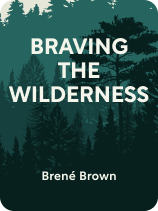

This article is an excerpt from the Shortform book guide to "Braving the Wilderness" by Brené Brown. Shortform has the world's best summaries and analyses of books you should be reading.
Like this article? Sign up for a free trial here.
What’s Braving the Wilderness by Brené Brown about? What does it mean to truly belong in society?
It’s natural to want to fit in and be a part of a social group, but sometimes people lose who they truly are to do so. In Braving the Wilderness, Brené Brown says that people should focus on expressing themselves for who they are, rather than giving themselves up for social acceptance.
Read below for a brief overview of Braving the Wilderness.
Braving the Wilderness by Brené Brown
The desire to feel accepted by others is one of the most powerful human motivators—it dictates how we speak and act to feel like we belong to a group. But according to researcher Brené Brown, striving for social acceptance instead of being true to ourselves breeds isolation and division by fueling the fear that we’re one misstep away from exclusion.
True belonging, she says, is the ability to express ourselves honestly. While it sounds counterintuitive, true belonging doesn’t mean finding people who accept you—rather, it means embracing the idea that being true to yourself supersedes what anyone else thinks.
Brown’s research focuses on courage, vulnerability, shame, and empathy. She explores these topics in public speaking events, podcasts, training programs, and her New York Times best sellers I Thought It Was Just Me (But It Isn’t), Atlas of the Heart, Dare to Lead, The Gifts of Imperfection, and Daring Greatly. In Braving the Wilderness, Brené Brown focuses on how we can achieve true belonging in a society where politics are increasingly divisive, and it’s harder than ever to be honest about our values and beliefs without facing hostility.
What Is True Belonging?
Brown says that true belonging is feeling secure in communicating and living out your values despite what others may think. In contrast, fitting in means conforming with other people’s expectations. For example, if your family is talking about politics at the dinner table, and you disagree with everyone else, you might embody true belonging by challenging their opinions or explaining why you believe differently, even if it’s uncomfortable. Fitting in might look like nodding along with what others are saying to avoid a potential conflict.
Prerequisites and Tradeoffs of True Belonging
Brown emphasizes that true belonging requires bravery and vulnerability. You have to be brave to say what you believe and feel, even when doing so risks rejection and backlash from the people around you. They could be dismissive and rude—or your speaking up can pave the way for a thoughtful discussion.
These are the tradeoffs of true belonging: You risk facing potential backlash, but you gain the possibility of meaningful dialogue and inner peace as a result of genuine self-acceptance. This is why Brown’s central metaphor for this challenge is the “wilderness”—a place where you never know what difficulties await and where you might feel alone and intimidated, but where you might also have some of the most rewarding experiences of your life. For example, in the previous scenario, if you speak up about your political beliefs, you may walk away from the situation with a sense of peace because you were honest, and with greater conviction in your beliefs.
In the rest of the guide, we’ll explore the ways people try to fit in rather than striving for true belonging. We’ll also describe the strategies you can use to achieve true belonging by speaking your truth while respecting the humanity of others.
Ways We Try (and Fail) to Belong
Brown explains that we tend to strive for belonging by trying to fit in. However, by trying to fit in, we find ourselves more isolated and afraid to express ourselves authentically. In other words, it takes us farther from true belonging. Here’s how this process unfolds:
In our attempt to feel socially connected (and therefore feel like we belong), we group ourselves by ideology, race, politics, and more. We try to bolster our connection to these groups, but our strategies for doing so—like using dehumanizing language toward outsiders—fuel divisiveness, causing us to forget the humanity of anyone who’s not “one of us.” According to Brown, this lack of a shared sense of humanity, a lack of compassion, and the fear of becoming an outsider are the primary reasons people struggle to achieve true belonging.
In the rest of this section, we’ll explain the two ways people try to fit in with a group and how these strategies lead us away from true belonging. These include: 1) self-monitoring to an unhealthy extent and policing the opinions of others within a group and 2) trying to connect with people through shared hate.
Self-Monitoring and Policing Opinions Within a Group
Brown explains that the instinct to find like-minded people becomes counterproductive when we believe that everyone in a group must agree on everything or else be ostracized. This thinking results in people policing what others within a group are saying, and it also leads to people self-monitoring to make sure they’re not stepping out of alignment with the group. These behaviors make people feel less connected and afraid to express themselves honestly because inclusion in the group is conditional—it relies on conformity.
For example, say you have a friend group that generally agrees on big political issues. However, when the issue of climate change comes up, you find that you have slightly different opinions: Your friends believe that the government should enforce strong regulations in the energy industry, and while you agree that policy reforms are important, you also worry about the economic implications of the policies they advocate. In this scenario, you might feel afraid to express your opinion, thinking the others will be offended by your stance and won’t want you in their friend group. As a result, you feel isolated and uneasy because you’re hiding part of yourself.
In addition, Brown suggests that if you’re making other people feel like they shouldn’t openly disagree with you, this prevents you from understanding that despite our differences, we’re all connected to one another as humans. This is because if you’re policing others’ opinions, you’re focusing on what divides us rather than the underlying values that unite us. For example, returning to the climate policy example, the opinions of you and your friends likely stem from the same underlying value of compassion: You want to avoid job loss due to policy changes, and your friends want to mitigate the impact of climate change on people.
Bonding Through Shared Hate and Using Dehumanizing Language
Another way people try and fail to feel like they belong is by bonding with others through shared hate of another group or person. However, Brown warns, a bond based on an “us versus them” mindset is superficial: It’s not built on trust or a sincere desire to cultivate a relationship, but rather on the instant gratification of what seems like connection when you’re swapping gossip or ranting about something you both despise.
Besides the lack of trust in this dynamic, Brown identifies another problem with this strategy of bonding through shared hate: It often causes people to use dehumanizing language toward other people or groups, which increases violence toward those groups and fosters more fear and disconnection. This makes true belonging more difficult.
For example, using the phrase “Bible thumper” to refer to anyone religious is dehumanizing because it reduces their identity to their faith and implies that the person has extremist views. Another example of dehumanizing language is the term “social justice warrior,” which might be used to mock and trivialize liberal activists.
According to Brown, using dehumanizing language like this toward a group makes it easier for someone to harm people in that group—for example, by advocating legislation to curb another group’s rights or by reacting violently to those people in public. Rather than bringing people together, shared hate results in a diminishing ability to have a respectful dialogue or relationship with anyone viewed as “other.”
How Can You Achieve True Belonging?
Now that we’ve covered some of the harmful ways we strive to connect and belong, we’ll explain Brown’s advice for finding true belonging. Her strategies include the following: 1) resolve conflicts with curiosity and healthy boundaries, 2) question false dichotomies (like the “us versus them” mindset), 3) remember what unites us as humans by being present with others through euphoric and painful moments, and 4) build trust in both yourself and others. We’ll cover each of these strategies in more detail next.
Strategy 1: Resolve Conflicts With Curiosity and Healthy Boundaries
Recall that Brown says part of true belonging means speaking up with your honest opinion, even when it could create conflict. This means you must be prepared to resolve conflicts by approaching them with curiosity rather than defensiveness or hostility. If everyone could try to understand other people’s perspectives and talk through conflicts with kindness, Brown says, people would feel more comfortable being their true selves because they wouldn’t be afraid of a negative reaction.
In other words, having a safe space to disagree facilitates true belonging. Even a more neutral stance, like “Since we disagree on this topic, let’s not talk about it,” hinders connection and true belonging because you might feel like you have to suppress your opinions to avoid conflict.
For example, in the earlier scenario of friends who disagree on climate change policies, Brown might recommend that the friends show curiosity by asking each other questions about why they believe the way they do: “What’s your rationale for this stance? How do you think this policy might affect people?” Brown emphasizes that this dialogue should always be respectful and should allow each person to understand the other’s intentions. In this case, the friends who disagree may have the same intention: reducing the impact of climate change in the most practical way possible. They simply have different approaches to doing so.
Brown’s conflict resolution strategy comes with a caveat: It should always be done with healthy boundaries in place. This means that you shouldn’t engage with someone if you feel physically or emotionally unsafe. For example, if someone is trying to physically threaten or intimidate you, or if they’re using dehumanizing language, this isn’t a safe space for productive conflict resolution. In this case, extract yourself from the situation rather than engaging.
Strategy 2: Question False Dichotomies
Brown’s next piece of advice for achieving true belonging is to question false dichotomies—the types of things people might say when they have the “us versus them” mindset. For example, if someone says that you can’t consider yourself a Christian if you hold certain opinions, this assertion is a way of trying to bully you into either conforming or losing your membership in a community.
In these situations, Brown says that true belonging requires calling people out on this and adding nuance while staying respectful. In this scenario, you might point out that many Christians have different opinions, explain why you think your opinion and faith aren’t mutually exclusive, and try the conflict resolution techniques we described in the previous section.
Strategy 3: Remember What Unites Us as Humans
Another way to foster true belonging is to increase our shared connection as humans. Brown says we can remember what unites us by being present with others during euphoric and painful moments. These include gatherings of people—especially with strangers—such as a group working together on a task (like building a house) or a large protest.
The commonality in these gatherings is a shared emotional experience: Love, grief, and everything in between are what bind us together as humans, no matter how different we may seem or how challenging it can be to relate to one another. Brown notes that in-person interactions are essential for feeling the power of a shared emotional experience because digital “gatherings” don’t quite have the same impact as being together in the same physical place.
Strategy 4: Build Trust
Building trust is another key way to achieve true belonging. Brown says that trusting yourself as well as others will help you express your true self and avoid withdrawing into yourself or lashing out at others out of fear. Her definition of trust has several elements. To understand what building trust looks like in practice, we’ll explain each of these elements using Brown’s acronym BRAVING:
Boundaries: When you trust yourself, you know when to draw the line at physical and emotional safety during a disagreement. When you trust other people’s boundaries, you know that they’ll do the same.
Reliability: When you’re reliable, people can trust that you’ll always be honest and won’t pretend to conform for ease. They know that you always show up as your authentic self. People should also be able to trust that you’re reliable because you don’t present them with false dichotomies.
Accountability: If you’re trustworthy, you take accountability when you mess up by not being authentic or not engaging in conflict resolution in good faith. In those cases, you show accountability by apologizing and trying again.
Vault: You keep things confidential when you say you will—even if you’re tempted to connect with people through gossip or shared contempt.
Integrity: When you have integrity, you always live out your values, even when it’s more challenging than conforming. This is an important part of calling out false dichotomies and being honest with others.
Nonjudgment: In order for people to trust you with their truth, you have to listen to them without judgment. Likewise, to trust yourself, you have be nonjudgmental toward yourself even when you feel different or “othered.”
Generosity: When people trust you, they know that when you ask more questions to understand their perspective, you’re assuming generous (good) intentions and you’re approaching the conversation with kindness.

———End of Preview———
Like what you just read? Read the rest of the world's best book summary and analysis of Brené Brown's "Braving the Wilderness" at Shortform.
Here's what you'll find in our full Braving the Wilderness summary:
- What true belonging means and why you shouldn't strive to be accepted
- Why it can be so challenging to be truly genuine
- 4 strategies for how to find true belonging






